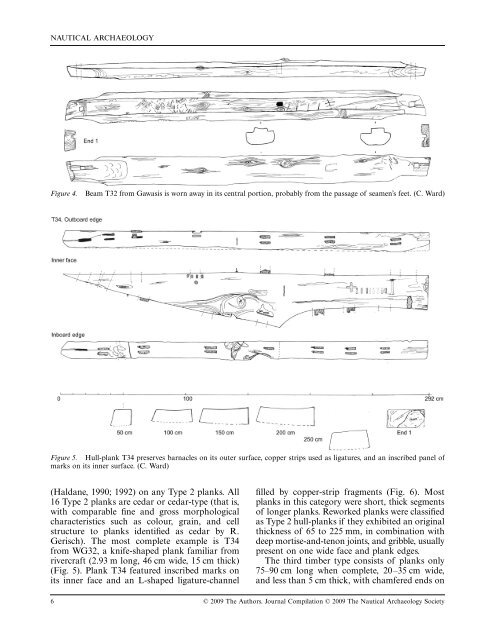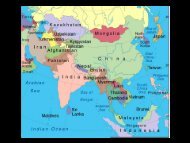Evidence for Pharaonic Seagoing Ships at Mersa/Wadi Gawasis ...
Evidence for Pharaonic Seagoing Ships at Mersa/Wadi Gawasis ...
Evidence for Pharaonic Seagoing Ships at Mersa/Wadi Gawasis ...
Create successful ePaper yourself
Turn your PDF publications into a flip-book with our unique Google optimized e-Paper software.
NAUTICAL ARCHAEOLOGY<br />
Figure 4. Beam T32 from <strong>Gawasis</strong> is worn away in its central portion, probably from the passage of seamen’s feet. (C. Ward)<br />
Figure 5. Hull-plank T34 preserves barnacles on its outer surface, copper strips used as lig<strong>at</strong>ures, and an inscribed panel of<br />
marks on its inner surface. (C. Ward)<br />
(Haldane, 1990; 1992) on any Type 2 planks. All<br />
16 Type 2 planks are cedar or cedar-type (th<strong>at</strong> is,<br />
with comparable fine and gross morphological<br />
characteristics such as colour, grain, and cell<br />
structure to planks identified as cedar by R.<br />
Gerisch). The most complete example is T34<br />
from WG32, a knife-shaped plank familiar from<br />
rivercraft (2.93 m long, 46 cm wide, 15 cm thick)<br />
(Fig. 5). Plank T34 fe<strong>at</strong>ured inscribed marks on<br />
its inner face and an L-shaped lig<strong>at</strong>ure-channel<br />
filled by copper-strip fragments (Fig. 6). Most<br />
planks in this c<strong>at</strong>egory were short, thick segments<br />
of longer planks. Reworked planks were classified<br />
as Type 2 hull-planks if they exhibited an original<br />
thickness of 65 to 225 mm, in combin<strong>at</strong>ion with<br />
deep mortise-and-tenon joints, and gribble, usually<br />
present on one wide face and plank edges.<br />
The third timber type consists of planks only<br />
75–90 cm long when complete, 20–35 cm wide,<br />
and less than 5 cm thick, with chamfered ends on<br />
6 © 2009 The Authors. Journal Compil<strong>at</strong>ion © 2009 The Nautical Archaeology Society







